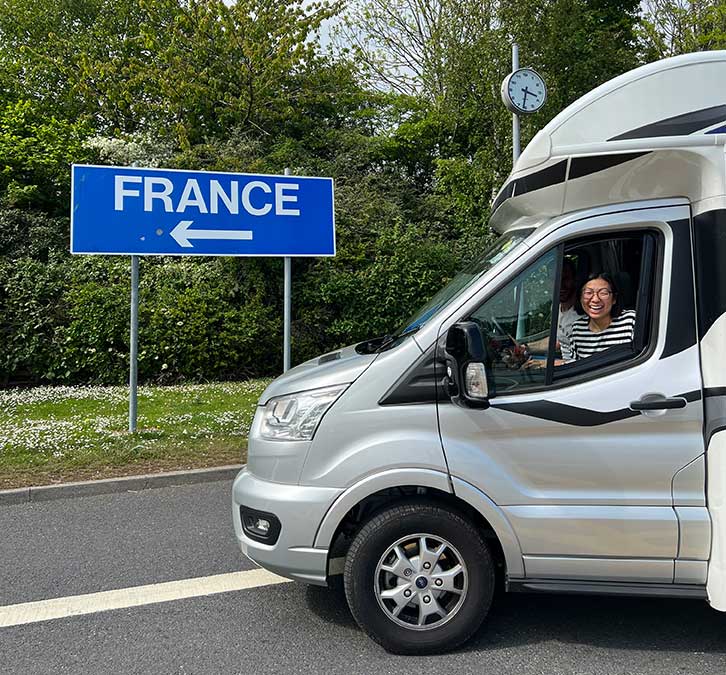When it comes to planning a European tour one of the main questions is; ferry or Eurotunnel? Since setting off on the Big European Odyssey we have used both, and are here to give a frank and honest comparison of the two services to help you decide which is best for you. Our experiences have taught us a lot, and there are now numerous things we wish we’d known before we set off on a motorhome tour of Europe.
However, before we go into more detail on the pros and cons of each option the first thing to consider is where do you actually plan to go in Europe, as to a large extent this might answer your question. For example, if you are heading to Spain then a ferry from Portsmouth to either Santander or Bilbao would, in our opinion, be a far more logical option. But, on the other hand, if you’re heading to Northern Europe then for ease of travel taking your motorhome on the Eurotunnel would be the best option.
Now let’s take a closer look at the two options, all the while keeping in mind the following information is based on our own personal experiences and that there is no right or wrong answer to which service is best when you’re choosing between Eurotunnel or Ferry.

Eurotunnel or ferry? The pros and cons:
The pros of taking your motorhome on the Eurotunnel
Speed of Travel
The biggest advantage of using Eurotunnel is how quick the entire process is. Even crossing during the busier periods we have never had a journey, including all passport controls and security checks, that has lasted over two hours. In low season this process comes down to no more than an hour, which is particularly appealing for us travelling with small children who can, as children do, get restless just sitting in the motorhome.
Ease of Process
We have never had any issues with the process of using Eurotunnel, be it the booking phase on their website or the travel aspect itself. Other than the passport controls and checking to see if your gas is switched off, everything else is automated and straightforward.
Flexibility
With up to four services per hour (in peak season) you can pretty much travel whenever you want, which is a huge advantage when planning travel either side of the Eurotunnel. Not only that but if you arrive early or late, within two hours either side of your original booking time, you can, subject to space, board a different departure.
So there’s no need to panic if you get held up in traffic or have any other means of delay to your journey getting to either Folkestone or Calais.
The cons of taking your motorhome on the Eurotunnel
Delays
During peak travel times, mainly school holidays, there can be long delays getting through passport control and security checks. It is worth mentioning that we haven’t personally travelled during such times, and so this information is based on what we have been told by other families.
Location
The Eurotunnel runs from Folkestone to Calais, which for some people is not an issue at all. However, for many it is something of an inconvenience both in terms of getting to Folkestone, and then also the onward journey once in mainland Europe.
Depending where in the UK you are starting your journey from it could mean a day’s travel just to get to Folkestone, although if this is the case there’s a great Caravan and Motorhome Club site within a stone’s throw of the port, meaning you can break your journey up. Equally there’s a great site on the CAMC’s European Network forty minutes drive the other side.
Ferry
The pros of using the ferry
Convenience
With there being many different departure and arrival ports in England and Europe for a lot of people the ferry is the most convenient way to travel to mainland Europe. It allows a far greater degree of flexibility in route planning, and in some cases cuts out a huge amount of driving to get to where you want to be. The best example of this is for those travelling to Spain, where a ferry means you don’t have to drive the length of France.

Break from driving
Given how quick the EuroTunnel crossing is there can be little respite from the driving, which for some m might not be a problem, but for others it is an issue. However, on the ferry there is a definite break from being behind the wheel, and in the cases of the longer crossings you will have a cabin and the chance to sleep.

Adventure:
For those travelling with children there is no doubting the fact that taking the ferry adds to the sense of adventure, especially on the newer ships. Brittany Ferries in particular have great onboard entertainment for children, both inside and outside, to help make the crossing as fun as possible.
The cons of using the ferry
Time
There is no escaping the fact that taking the ferry takes longer than taking your motorhome on the Eurotunnel, although depending on your final destination, when you factor in driving time, it can be similar time frames. The actual process of boarding and debarking is more time consuming than the Eurotunnel and some ferry times have also increased with the launch of new boats that now use a more eco-friendly fuel, LNG (liquefied natural gas) – not that protecting the environment is in any way a bad thing.
Weather
There’s no controlling Mother Nature and this means when on a ferry you are subject to her whim and could end up sailing during storms. We have been fortunate on our crossings to avoid such bad weather, but it can make for a pretty torrid time at sea if you’re unlucky enough to encounter a storm.

Limited Crossings
Keep in mind that on longer routes there are far fewer crossings. For example travelling from Portsmouth to Santander with Brittany Ferries, which is the route we use most, there are only two boats a week.
So now to the elephant in the room; the cost. The reason we have left this to the end, and kept it as a separate focal point is because it needs some extra explaining. There will be those who say that the cost of using the ferry is more expensive, which at times when taken as a stand alone price, it can be. But there are other elements to take into consideration.
For example, if you’re travelling to Spain then you need to look at the bigger picture. While the ferry might be more expensive than EuroTunnel, once you add in the cost of fuel and tolls to drive through France, as well as a few campsites along the way, then the cost is suddenly about the same. And so it comes back to a question of convenience and time. If you have the luxury of a longer time away then driving down through France can be great fun. But for those on a tighter schedule the ferry takes a lot of hassle out of the trip.
In order to keep costs down our advice is to book as far in advance as possible, and keep in mind that the Eurotunnel is much cheaper if you travel late at night. We also book through the Caravan and Motorhome Club, and have found prices to be cheaper when going through their site. It also means you can book all elements of your trip in one place; sites, crossings and insurance.
In conclusion we come back to the point we made at the start of the blog; there is no right or wrong answer as to which is the best way to cross to Europe. It all comes down to personal preference and what works best for your specific trip. Which just leaves us to say, happy travels and don’t forget you can follow our adventures over on Instagram – @marcusleachglobal and @our.roaming.odyssey.
If you are heading back from Europe, don’t miss Motorhome Matt’s tips on how to avoid stowaways in your motorhome as you return to the UK.
If you enjoyed this, you can catch up on more from the Big European Odyssey:
- Marcus Leach and family share how they prepared for their tour of Europe.
- We find out about the practicalities of adapting to life on the road.
- There are some essential items you should consider taking on a European tour, as Marcus Leach explains.
If you’ve enjoyed reading this article, why not get the latest news, reviews and features delivered direct to your door or inbox every month. Take advantage of our brilliant Practical Motorhome magazine SUBSCRIBERS’ OFFER and SIGN UP TO OUR NEWSLETTER for regular weekly updates on all things motorhome related.









